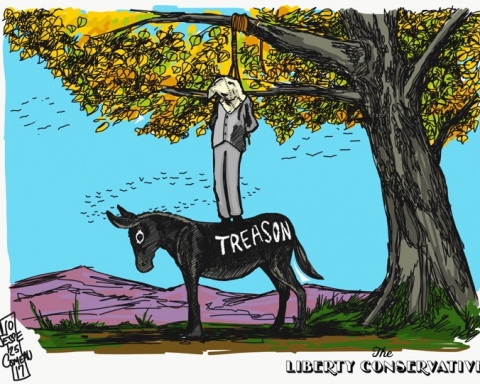One of the more transparently manipulative and hypocritical slogans used by Western Communist Parties in the mid 1930s to recruit allies for Stalin was specifically designed for Catholics:
“You can still take Communion and love the Soviet Union.”
Graham Greene, novelist, pundit, and above all, Catholic, embodied this slogan.
Indeed, Greene’s attempts to link Catholicism with a Soviet Union that persecuted priests from the get-go predated this slogan. Since the 1920s, Greene had sought to merge his Catholic faith with his Communist one, which prompted George Orwell, a foe of both organized religion and communism, to label Green the first “Catholic fellow traveler.”
But even today, an argument is made that Greene was hostile to Communism in whatever form it took until his death in 1991.
This school of thought relies on criticisms Greene made toward the ideology throughout his life.
Witnessing Communist behavior in Mexico in the 1930s, Greene attacked both Catholicism and Communism for their unconcern with “human rights.” He later sought to distance himself from his fellow intellectuals who fell hard for Stalin in the 1930s, declaring that “Their God failed.”
Greene also compared his Church with Stalinist persecution, once writing that, historically, Catholics had their “own Stalinist periods, thousands of them—Torquemada and the Spanish Inquisition.” Visiting Vietnam while still a French colony in the 1950s, Greene expressed that he “had a great deal of sympathy for the French in Vietnam.”
A decade later, Greene condemned the 1968 Soviet crackdown on their Czechoslovakian satellite as revealing that ”the days of ideals—and ideologies which are their political expression—are certainly over…[and] that morality counts for nothing in international politics.”
In 1971, he stated that he was against the “’Russian version’ of Communism” which he disliked even in its “post-Stalin” form. He even refused the Order of Lenin medal awarded him by the Soviets, but there was a yin to this yang, and the Soviets were on the mark when recognizing that Greene earned such an award.
Even when admitting the “great crimes” committed by “Communists”—and Catholics—Greene nevertheless justified said crimes because both had “not stood aside, like an established society, and been indifferent” to poverty. As such, he stated that “I would rather have blood on my hands than water like Pilate.”
Because of these supposedly shared sentiments, Greene paid both the ultimate compliment by stating that one could easily be a member of both ideologies. “There is no reason why a Communist should renounce his Catholic faith,” he said.
To find scriptural backing for such a combination, Greene cited the Epistle of James, whose warnings to the rich represented “words of revolution.”
And although supposedly distancing himself from Soviet communism, Greene nevertheless preferred it over American democracy.
In 1967, a decade after the brutal Soviet crackdowns on Poland and Hungary, both of whom authentically sought the sort of humane revolution Greene supposedly championed, the writer stated his preference for the Soviet Union over the United States:
“If I had to choose between life in the Soviet Union and life in the United States of America, I would certainly choose the Soviet Union. Russians only destroy its body, whereas the Americans destroy its soul.”
Greene traced the American war on religious salvation to how “solidly anchored…American materialism” was in the country. By turns, the “less solidly anchored…Russian materialism” allowed the existence of “a latent sense of religion.”
Such religious possibilities Greene cited as the “chief reason why I have felt a sort of attraction to Communism.”
This bizarre attraction included defending, even admiring on the basis of their faith, Soviet spies who betrayed Greene’s country. When his former intelligence boss and friend Kim Philby validated accusations that he was a Soviet mole by defecting to Moscow, Greene lauded the spy’s faith in Russia as akin to the religious faith of a devout Catholic.
But whatever supposed ambivalence Greene felt toward the Soviets was not in evidence regarding third world communism.
For despite his 50s era support of the French war against Vietnam, Greene opposed “American intervention” to the extent that he “became even more a Communist sympathizer.”
Regarding the Cuban communist dictator Fidel Castro, Greene typically short-circuited any criticisms he had toward Castro such as the dictator’s “authoritarianism” with praise. In spite of Greene’s awareness of how the regime cracked down on religious freedom, he nevertheless praised Castro’s fight against so-called American imperialism ’til the end of the writer’s life.
Such faint criticisms were not applied, however, to the Stalinist-style Sandinista government in Nicaragua in the 1980s. Instead, he fell unreservedly hard for it because he saw it as merging Church with State.
In contradiction to his characterization of a materialism-free Soviet Union, he praised the Sandinistas for attempting to keep the materialism of both the Soviets and the US at bay by allying with neither (both the Soviets and the Cubans funded the regime in actuality).
Free from such supposed religion-destroying materialism, Greene approvingly saw the regime as having the flexibility to move beyond their policies supporting freedom of religion toward an actual merging of Church with State by allowing Catholic priests into the government. Because of this, Greene gushed that the Sandinista regime was in fact a “Roman Catholic government.”
When confronted with undemocratic and outright anti-religious behavior of the Sandinistas, Greene still defended the government for its supposed pro-Catholic policies. The regime repeatedly refused free elections (and when they were held under UN supervision, the Sandinista secret police allowed a mob to attack voters standing in line with machetes) as well as persecuting, among others, a Catholic priest named Obando y Bravo for criticizing the actual nature of the regime.
Regarding the Soviets, Greene never gave up his “dream” of Russia allying with the Catholic Church. In a moist 1987 paean to Gorbachev given in Moscow, two years before the General Secretary’s democratic reforms—inadvertently—destroyed the Communist country; Greene wanted the still-totalitarian government to partner with the Catholic Church.
In this speech before the Soviet congress, and Gorbachev, the writer spoke of “his dream…that perhaps one day before I die, I shall know that there is an Ambassador of the Soviet Union giving good advice at the Vatican.”
Such an enthusiasm led Greene into opposing the democratic Polish Solidarity movement and instead supporting the Polish Catholics who in turn supported their Soviet-controlled government.
Today, there is nothing particular new about Catholics and Protestants defending Communist regimes on religious grounds (evidence to the contrary, the United Methodist Church credits the Cuban regime for its “religious tolerance”). But Greene was a pioneer of it, and went far beyond reformed Communist spy Whittaker Chambers’ famous–or depending upon your point of view–infamous breakdown of religion being about “faith in God” versus communism’s “faith in Man.”
Instead, Greene subscribed to both faiths and frequently defended his Church partnering with any Communist State, no matter the bloody history of the former and the repressive crackdowns by Communist regimes on their religious citizens.
But Greene’s faith in both held fast until his death, and he used them to defend Communism on religious grounds, and vice versa.









